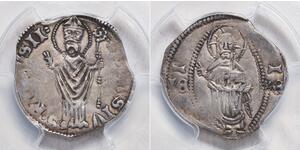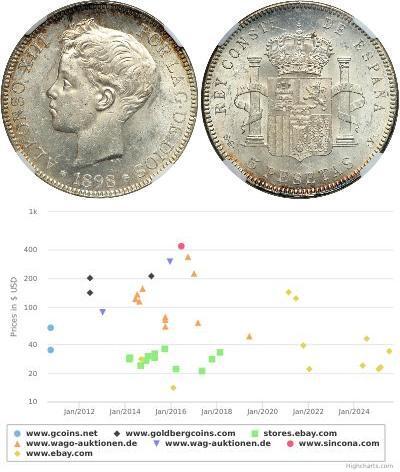(продана за $69.0)
1463, Bologna (City), Giovanni II Bentivoglio. Broad Silver Grossone Coin. VF+
Denomination: Grossone
Mint Place: Bologna (City)
Mint Period: 1463-1506 AD
Condition: Dark deposits spots in fields, otherwise VF+ and rare!
Reference: CNI 63, Ch. 194. var. (the legend in reverse ends there with STVDIORVM °)
Diameter: 29mm
Material: Silver
Weight: 3.27gm
Obverse: Enthroned figure of Saint Petronius, holding model of a castle in right hand.
Legend: . S PETRONI DE BONONIA
Reverse: Initial (IPRT), split by pellets within inner circle.
Legend: ° BONONIA ° MATER ° STVDIORV °
Saint Petronius (Italian: San Petronio) (died ca. 450 AD) was bishop of Bologna during the fifth century. He is a patron saint of the city. Born of a noble Roman family, he became a convert to Christianity and subsequently a priest. As bishop of Bologna, he built the Church of Santo Stefano. The only certain historical information we possess concerning him is derived from a letter written by Bishop Eucherius of Lyon (died 450-455) to Valerianus (in P. L., L, 711 sqq.) and from Gennadius' De viris illustribus, XLI (ed. Czapla, Münster, 1898, p. 94). Eucherius writes that the holy Bishop Petronius was then renowned in Italy for his virtues. From Gennadius we receive more detailed information: Petronius belonged to a noble family whose members occupied high positions at the imperial Court at Milan and in the provincial administrations at the end of the fourth and the beginning of the fifth centuries. His father (also named Petronius) was probably prœfectus prœtorio, since a Petronius filled this office in Gaul in 402-408. Eucherius seems to suggest (P. L., L, 719) that the future bishop also held an important secular position. Even in his youth Petronius devoted himself to the practices of asceticism, and seems to have visited the Holy Places in Jerusalem, perhaps on a pilgrimage. About 432 he was elected and consecrated Bishop of Bologna, where he erected a church to Saint Stephen (Santo Stefano), the building scheme of which was in imitation of the shrines on Golgotha and over the Holy Sepulchre in Jerusalem. The buildings belong approximately to the period when Pope Leo I had basilicas erected in Rome and Galla Placidia in Ravenna. Petronius is believed to have written a work on the life of the Egyptian monks (Vitæ patrum Ægypti monachorum); the author of this work, however, is Rufinus of Aquileia. The treatise De ordinatione episcopi, bearing the name of Petronius as author, is by the elder Petronius, who was a man of eloquence and wide acquaintance with the secular sciences. Morin has published a sermon entitled "In die ordinationis vel Natale episcopi" (Revue bénédictine, 1897, 3 sq.), which Gennadius ascribes to Bishop Petronius of Verona, whom Czalpa holds is Petronius of Bologna, but this assignment is not certain. According to Gennadius, Petronius died during the reign of Emperor Theodosius II and Valentinian III, i. e., before 450. In the twelfth century appeared a legendary life of the saint, whose relics were discovered in 1141. Shortly afterwards a church was erected in his honour at Bologna; a second, planned on a large seal, was begun in 1390 (see San Petronio Basilica). The feast of St. Petronius is celebrated on 4 October. In iconography, he is depicted as a bishop holding a model of Bologna in his hand.
Authenticity unconditionally guaraneed.
Giovanni II Bentivoglio (February 12, 1443 – February 15, 1508) was an Italian nobleman who ruled as tyrant of Bologna from 1463 until 1506. He had no formal position, but held power as the city's "first citizen." The Bentivoglio family ruled over Bologna from 1443, and repeatedly attempted to consolidate their hold of the Signoria of the city.
Born in Bologna, Giovanni II was the son of Annibale I Bentivoglio, then chief magistrate of the commune, and Donnina Visconti. He was a child when his father was murdered by his rival Battista Canneschi in June 1445.
Annibale I was succeeded in Bologna by Sante I, of uncertain paternity and origin, but alleged to be a son of Ercole Bentivoglio, a cousin of Annibale I. Originally an apprentice of the wool guild of Florence, Sante ruled as signore of Bologna from 1443. When Sante died in 1463, Giovanni II Bentivoglio successfully made himself lord of the commune, although it was nominally a fief of the church under a papal legate. On May 2, 1464, he married Sante's widow Ginevra Sforza. In 1446 he obtained by Pope Paul II the privilege to be considered perpetual head of the city's Senate.
Machiavelli writes that Annibale, "having been murdered by the Canneschi, who had conspired against him, not one of his family survived but Messer Giovanni, who was in childhood: immediately after his assassination the people rose and murdered all the Canneschi. This sprung from the popular goodwill which the house of Bentivoglio enjoyed in those days in Bologna; which was so great that, although none remained there after the death of Annibale who were able to rule the state, the Bolognese, having information that there was one of the Bentivoglio family in Florence, who up to that time had been considered the son of a blacksmith [Sante], sent to Florence for him and gave him the government of their city, and it was ruled by him until Messer Giovanni came in due course to the government." (The Prince, Chapter XIX)
In order to secure the support of the other powerful families of Italy, Giovanni fought personally as condottiero. In 1467 he was at the service of Florence, Milan and Naples against Bartolomeo Colleoni, and in 1471 again for Milan, but his first military deeds occurred only in 1477 when he besieged Faenza for the Sforza. In 1482, during the War of Ferrara, he helped Ercole d'Este against Pope Sixtus IV and Venice. He later fought in small struggles for the Kingdom of Naples, but his personal interventions were always limited by the Bolognese institutions.
In 1488, his daughter Francesca poisoned her own husband, Galeotto Manfredi, ruler of Faenza. The latter's citizens considered the feat as an occult move to conquer the city, and rebelled. When Giovanni reached the city to suppress the revolt, he was captured. He was freed only through the intercession of Lorenzo de' Medici. In the same year he was made Capitano Generale (Chief of Staff) of the Milanese army, but this was an almost honorific position as Giovanni left the command duties to his sons. In 1488 Giovanni had also to crush a plot against him, led by the Malvezzi family, whose members were almost all hanged or exiled. In 1501, the same fate struck the Marescottis.
Bentivoglio had managed to resist the expansionist designs of Cesare Borgia, but on October 7, 1506, Pope Julius II issued a bull deposing and excommunicating Bentivoglio and placing the city under interdict. When the papal troops, along with a contingent sent by Louis XII of France, marched against Bologna, Bentivoglio and his family fled. Julius II entered the city triumphantly on November 10.
Giovanni moved first to Busseto, host of the Pallavicino family. An attempt led by his sons Annibale II and Ermes to reconquer Bologna in 1507 failed. The Bolognese subsequently rioted against his possessions in the city, destroying the palace.
Excommunicated, Giovanni ended his days as prisoner of Louis XII in Milan. He died in 1508 in the Castello Sforzesco of that city.
Giovanni Bentivoglio is said to have consulted in 1504 the famous astrologer Luca Gaurico about his and his sons' destiny. Displeased with Gaurico's negative prophecy, Bentivoglio subjected him to the torture of mancuerda, and exiled him from Bologna.
Giovanni II Bentivoglio ruled with a stern sway for nearly half a century, maintaining a splendid court and beautifying Bologna, in particular developing its waterways. The misery of the city's poor, however, stood in stark contrast to the splendor of the city and its festivities.
Among the projects he commissioned were the frescoes depicting the life of Saint Cecilia in the Oratorio di Santa Cecilia through the archway of San Giacomo. These frescoes were painted by artists living in the city at the time: Francesco Francia, Lorenzo Costa the Elder and Amico Aspertini. Lorenzo Costa's Bentivoglio Altarpiece, housed in the Bentivoglio Chapel in the church of San Giacomo Maggiore, was commissioned by Giovanni Bentivoglio as a votive offering of thanks for the family’s escape from an attempted massacre by the Malvezzi family. Bentivoglio also ordered the Palazzo Bentivoglio (City Hall) to be built by the architect G. Nadi, starting in 1498. The Bolognese architect Aristotile Fioravanti, who later settled in Russia, created the plans for the reconstruction of the Palazzo del Podestà, but the reconstruction was not carried out by Bentivoglio until 1484–94.

|
Добавив:
anonymous 2016-01-26 |
5 Цент Нідерланди
в групі 11 монет / 8 цін
⇑























